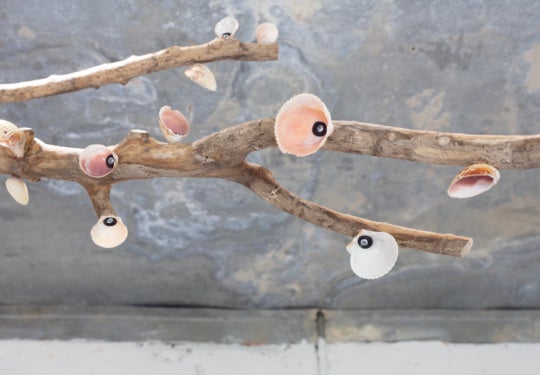
Leisa Rich’s extraordinary exhibition “grownupland,” which closes on January 13, has gone more unnoticed than it should have, in part because its host, Gallery 180, is centrally located but effectively invisible. Occupying the offices of the architecture firm Stanley Beaman & Sears at 180 Peachtree Street, it sits directly across from a downtown MARTA station but is unmarked, and accessible only to those who know to ask the concierge to admit them.
It’s useful to know beforehand that the show is meant to be a playfully grown-up updating of Rich’s childhood experience of Disneyland, to which her parents took her to celebrate her release from hospitalization for medical problems that included deafness. The visual and auditory impact of Disneyland’s color, animation, and music stayed with her.

So the four zones of “grownupland” represent Rich’s own mythic interior amusement park. She shares her experience with viewers by creating, as she puts it in her artist’s statement, “a unique world that shakes them up, assaults their senses, and suspends reality for a brief time, in order that we might be children again, playing together.” Actually, there are now only three zones; due to space limitations, “listenupland,” the zone devoted to auditory art, was removed after the opening, along with a major freestanding fabric sculpture, for another event held in the space.
“grownupland” indeed suspends ordinary reality in delightful ways. Just as the text of the show’s invitation claims, the first zone, “innocentland,” allows viewers to “walk the hallway of angelic presence,” in the form of lacelike or semi-organic white wall installations of stiffened fabric or 3-D printed plastic, plus a small pedestal-based sculpture consisting of stacked polyhedrons, which is a harbinger of things to come.

It is difficult to convey in language the funhouse effect of these varied swirls of not-quite-biomorphic shapes that suggest everything from bleached coral to a bunched-up chenille bedspread, and which are almost certainly not meant to recall either of those options. But the sensory experience is undeniable.
At the far end of the hallway, color emerges from the anything-but-monotonous monochrome where a wall-mounted swarm of butterfly sculptures erupts from the aforementioned stacked polyhedrons. Following their flight round the corner, we find ourselves in “hyperrealityland.” Here, the fantasia of freeform wall pieces are as brightly variegated as the previous ones were single-color, and eventually this dance of forms terminates in a peculiar combination of outline figures of birds (Night Watchers) filling the wall above a set of sculptural figures collectively named Ladies of the Night (with individual names to match: Candy Corn, Lola Lollipop).

Following the direction of the birds’ flight takes the viewer into “interactiveland,” where the previously freeform shapes combine into square plaques with alternately graceful and clunky shapes set into them. Viewers are invited to switch out the plaques on the wall with ones from a stack on the floor. (This work, of which individual parts can be purchased separately, is titled Play With Me…No, REALLY Play With Me.)
Thereafter, the invitations to interaction become ever more ambiguous, and the personal symbols ever more antic but murky. The stacked-polyhedron sculpture shows up in several successive guises, beginning with a colorful piece oddly titled Happy to See You, Too. (The limp shapes hanging off the polyhedrons are at most faintly phallic, so instead of alluding to the familiar joke, perhaps the title really does just relate to the happiness brought by kindergarten colors.)
When the polyhedronal shape recurs in black and white as Noir et Blanc, it appears on a pedestal beneath a series of wall plaques collectively titled Things Might Be Black and White … But I’m Seeing Red. Red is, in fact, a secondary color in this array of black squares (no, not Malevich-type black squares) inlaid with organic, vaguely biomorphic interventions in white. Beyond this literal meaning, the multilayered puns in the title seem to imply something more systematically symbolic, but I have no idea what.

The next wall (and Rich has adroitly divided the complicated space of the architecture office into thematic subtopics) is devoted to clear plastic bags containing plastic parts that could be assembled into—something or other. The accompanying pedestal sculpture of similarly random bits says it all—Leftovers Are the Best Kind.
The crocheted hanging sculpture at the far end of the office, The Woolding of St. Augustine, consists of little bags holding a number of fabric-covered balls. It is as randomly but resonantly esoteric as anything in the whole show. Like many other pieces here, the thing is vaguely comic, but I am at a loss to say just why.
What I can say with confidence is that all of this deserves to be visited before it gets taken down after January 13.
Jerry Cullum is a freelance curator and critic living in Atlanta. His poems, reviews, and essays have appeared in a wide variety of local and national publications, including Art Papers and Art in America.




